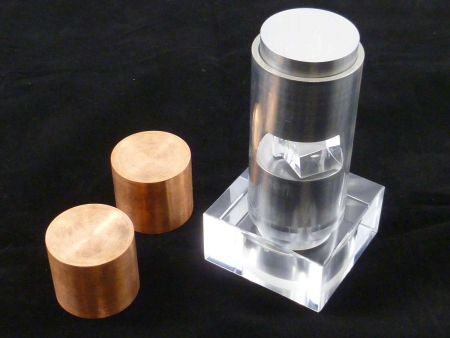Ice Melting Kit, Advanced
£42.84
£35.70
This advanced ice melting kit nicely demonstrates the thermal conductivity of materials by using different types of metal blocks to melt ice cubes.
Pack Size:
1
In stock
This advanced ice melting kit nicely demonstrates the thermal conductivity of materials by using different types of metal blocks to melt ice cubes. The kit consists of an acrylic base with sump, an acrylic tube, two cylindrical copper blocks and two cylindrical steel blocks.
The apparatus is set up by placing one of the copper blocks on top of the acrylic base. The base has an integral sump, which will contain the meltwater from an ice cube. The acrylic tube is then placed over the copper block, in order to contain the metal blocks and ice cube. An ice cube is then dropped down the tube onto the block and the second copper block is placed on top. Immediately the ice begins to melt, due to the high thermal conductivity of copper (along with large thermal mass), and in matter of 10-15 seconds the ice will have melted and disappeared.
By repeating the experiment using the steel blocks it can be seen that the ice melts more slowly, due to the lower thermal conductivity of steel.
Each experiment can be timed, for more accurate comparison between the two different metals.
The kit also includes two plastic insulating discs, which can be placed between the ice and the metal blocks to show that it is not simply the pressure of the top block which is causing the ice to melt.
If repeating the experiment using the same blocks, it is better to allow the blocks to come back up to room temperature first (if repeatable results are required).
Contents:
• Acrylic base and tube
• 2 x 0.5 kg copper blocks
• 2 x 0.5 kg steel blocks
• 2 x plastic insulating discs
Also required: Ice cubes, preferably quite large.
The apparatus is set up by placing one of the copper blocks on top of the acrylic base. The base has an integral sump, which will contain the meltwater from an ice cube. The acrylic tube is then placed over the copper block, in order to contain the metal blocks and ice cube. An ice cube is then dropped down the tube onto the block and the second copper block is placed on top. Immediately the ice begins to melt, due to the high thermal conductivity of copper (along with large thermal mass), and in matter of 10-15 seconds the ice will have melted and disappeared.
By repeating the experiment using the steel blocks it can be seen that the ice melts more slowly, due to the lower thermal conductivity of steel.
Each experiment can be timed, for more accurate comparison between the two different metals.
The kit also includes two plastic insulating discs, which can be placed between the ice and the metal blocks to show that it is not simply the pressure of the top block which is causing the ice to melt.
If repeating the experiment using the same blocks, it is better to allow the blocks to come back up to room temperature first (if repeatable results are required).
Contents:
• Acrylic base and tube
• 2 x 0.5 kg copper blocks
• 2 x 0.5 kg steel blocks
• 2 x plastic insulating discs
Also required: Ice cubes, preferably quite large.
| Pack Size | 1 |
|---|---|
| Gross Weight | 1.5 |
Write Your Own Review






